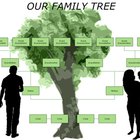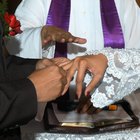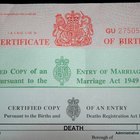
There are a number of ways to find lost relatives, both living and dead. Gathering even obscure clues and following where they lead will get you close to your goal. Start by getting as much information as you can from your living relatives and by researching your family history. Use your imagination. Some information will be easy to find online. Some will require telephone calls and visits to libraries and news archives. If all else fails, contact an expert to find lost relatives.
Check military records. File form SF-180 or write a letter to the National Personnel Records Center in St. Louis. Download the form or request a copy from your local Veterans Administration. You'll need specific information like a Social Security number, complete name and years of service.
Place a newspaper ad in towns where you think your relatives might have lived. Ask for any information about the family. Briefly explain that this is for personal reasons.
Talk to the neighbors if you have a relative's previous address. They may know when and where your relative moved.
Take a road trip to towns where your relatives lived. Visit the cemeteries, the library's local history section and town hall. Spend some time in the town's records department, checking births and deaths, marriages, deeds and whatever information the town considers public records.
Contact genealogical societies. Not only might they be able to help you, but they're always looking for more information to add to their files. You may be able to provide something useful. Visit genealogy websites.
Search newspaper archives. Do this online if the newspapers have created searchable archives. Visit a newspaper and ask to look at back issues or microfiche slides if the newspaper didn't keep online archives.
Check family Bibles. Family birth and death information is frequently written in them.
Related Articles

How to Find School Records for Family ...

How to Find Ancestry in Singapore

How to Find Out If a Family Member Has ...

How to Trace the History of a Name

How to Find a Date of Marriage

How to Legally Change Your Name When ...

How to Address an Envelope With ...

How to Find Obituaries From Over 10 ...

How to Find Family Military Photos

How to Find Cuban Relatives in Cuba

How do I Look for Genealogy in ...

How to Find Someone's Birth City & ...

How to Locate a Missing Person in ...

How to Find Someone's Relatives

How to Find a Person in Canada

How to Find Someone in Scotland

How to Trace Your Family Tree for Free

How to Change Your Name After Marriage ...

How to Apply for a Long-Form Birth ...

How Do I Find Out the Tax ID Number for ...
Resources
Tips
- Keep notes on all of the information you gather so you don't have to redo the search if you forget where you found it.
- Don't forget to check maiden names.
Warnings
- Adoption records are usually not open to the public.
- Respect the privacy of lost relatives who don't want contact with you.
Writer Bio
Meg Jernigan has been writing for more than 30 years. She specializes in travel, cooking and interior decorating. Her offline credits include copy editing full-length books and creating marketing copy for nonprofit organizations. Jernigan attended George Washington University, majoring in speech and drama.
Photo Credits
laptop image by Du...¡an Zidar from Fotolia.com